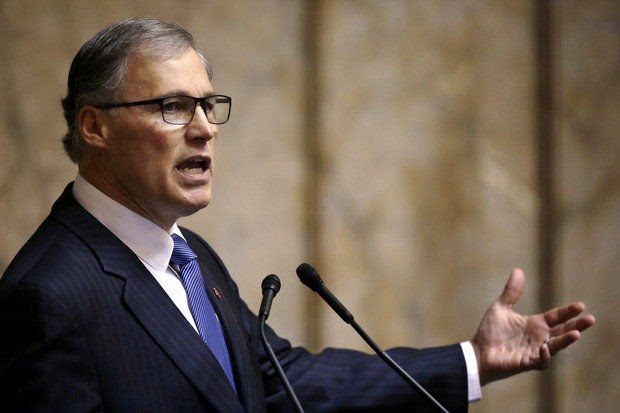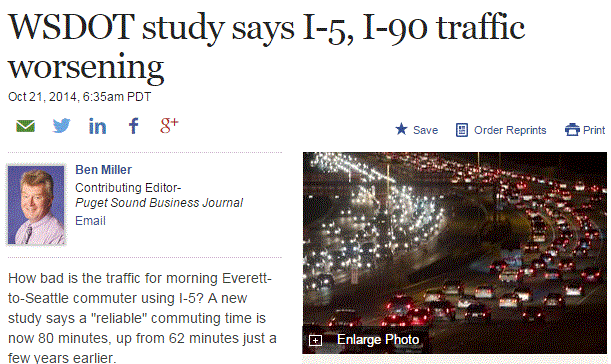In this blog I will suggest an alternative plan, that might be acceptable to both sides of the aisle. Maybe.
Washington Governor Jay Inslee
Recently, Governor Inslee announced a climate action strategy, centered around a one-billion dollar cap and trade plan. And he has made several executive decisions to support clean energy.
But I am worried about whether his approach will be effective. Recent changes in the makeup of the Washington State legislature have reduced the chances that any cap and trade plan will be enacted--and the success of cap and trade in other venues has not been impressive.
So if I was Governor, what would be MY program?
Here is my plan:
I. Secure a better understanding of how our climate has changed during the past century and how it will change during the next 100 years.
If our state is going to deal with climate change, we must understand what has happened and what will happen. You can't make robust policies without solid information, right? As a weather/climate scientist let me assure you there are major weaknesses in our knowledge on both counts--but with some effort we can fix the deficiencies.
Step 1: Strengthen the Office of the Washington State Climatologist (OWSC).
OWSC has the responsibility to collect climate data for the State and to make it available to WA citizens and decision makers. To provide a clear picture of previous changes in our state's climate. This office is woefully underfunded (with a budget about 60K). There is so much that they could and SHOULD be doing, but there is no funding. The Governor and Legislature need to fix this. Soon.
Step 2: Begin an active program of regional climate simulation to get a far better understanding of the future regional implications of climate change.
To deal with Northwest climate change, it is essential to have reliable guidance on what will happen during the next century. The guidance used today can be dramatically improved. Global climate models do not produce consistent results about the regional implications of increasing greenhouse gases, and most of these models are far too coarse to consider the critically important terrain of the region. To plan for the future, our state needs much better information, and there is a way to get it: high-resolution regional climate models. Secure a large number of global climate models and strain out the models that fail to get the current climate right. Then run a high resolution regional climate model for each global simulation to get the local implications (see sample below), and apply sophisticated statistical post-processing to provide calibrated regional climate predictions.
A regional climate prediction effort should be established immediately, with support from the State and others. In fact, a group of us have developed a plan to do so, found here. Hopefully, we will be able to find some support for the effort. The technology to secure far better future climate information is available and Governor Inslee should make regional climate prediction a top priority. This could be highly bipartisan and would supply regional planners with the information they need for resilience and adaptation planning.
II. Make our region more resilient to current conditions and future climate change.
Step 3: Begin adaptation planning and infrastructure improvements.
Too many environmental activists look at adaptation as a dirty word, as if getting ready for future changes will lessen enthusiasm for mitigation (reducing emission of greenhouse gases). But the truth is that our society is not sufficient resilient to the CURRENT climate (e.g., the Oso landslide) and climate change will bring new stressors. Substantial global warming is going to happen--we are simply not doing enough to stop it. Therefore, the State and our Governor needs to make resilience and adaptation a priority--one that will pay great dividends no matter what happens. What could be part of the Governor's resilience plan?
a. Complete a lidar survey of the state to find all historical landslide locations. Heavy precipitation is clearly going to increase under global warming and thus flooding and landslides will too. Using the best advice of geomorphologists, our State must establish restrictions on new construction in vulnerable areas and begin the process of moving people from dangerous locations.
b. Evaluate whether new reservoir capacity is needed in eastern Washington. Even today, there are years in which water for agriculture/fish is a problem; what about 30-100 years from now? There is already some discussion of expanding current reservoirs and/or adding new facilities. A detailed examination of this issue, informed by the regional climate simulations noted above, is needed. Beyond adaptation, should reservoir capacity be increased to allow a massive enhancement in eastern Washington agriculture to make up for the agricultural loses in increasingly drought-stricken California? Folks need to eat. Perhaps a huge opportunity for WA State agriculture.
c. Considering the potential for increased river flooding, we must evaluate current development near rivers and begin the process of moving people away from vulnerable areas. This may involve a buy-out program of some homes and businesses. It also may include improved dikes and water works.
d. Evaluate ways to lessen the impacts of sea level rise along the coast and near inland waterways.
In short, the State must begin a comprehensive evaluation of the threats to life and property accompanying global warming and then come up with and fund an explicit action plan to make the State less vulnerable for both current and future climate variations. (see carbon tax below)
Everything mentioned above is relatively uncontroversial. Now lets consider other parts of my climate plan.
III. Deal with the regional transportation grid lock.
Few things waste more energy and provides more of an economic drain on the Puget Sound region, the economic engine of the State, then the worsening traffic crisis. It is not only bad, but has gotten much worse in the last few years. Unfortunately, regional political leadership has been extraordinarily ineffective in solving this crisis and the Governor needs to push the legislature and localities to get serious about transportation. Consider just a few examples of local failures:
1. As traffic has increased, King County Metro CUT bus service, with long wait and inadequate service on important commuter routes.
2. Rail service north and south (Sounder trains) is not only infrequent but is often stopped, for days and weeks, by mudslides on the tracks south of Everett. Here we have a nation that could put a man on the moon, but we can't seem to stabilize a few miles of slopes above the tracks. Sad.
3. The city of Seattle has let crucial bicycle routes deteriorate (e.g., the Burke Gilman trail) and has failed to establish a safe north-south route into the city. Instead they are putting millions in a bicycle rental system (Pronto) that is barely used and has painted bicycle symbols on streets (sharrows).
4. A wonderful north-south rail corridor on the east side (where 405 traffic is at a standstill all the time) is GIVEN UP for a recreational trail. Imagine if fast commuter rail went in instead. How in the world did this happen.
5. Seattle light rail south of Seattle does not have its own right of way and is amazingly slow as it gets stuck in lights or gets into accidents with motor vehicles.
I could list a dozen more examples, but the message is clear: local politicians have been missing in action in dealing with regional gridlock. The governor needs to deal with this. Some ideas to start:
More buses and frequent service especially for important commuter runs.
Repair and extend bike trails
End the slide mess and add more Sounder trains.
Use Uber/Lyft/taxis for less traveled bus routes to reduce use of expensive large buses.
Expand light rail around Seattle, particularly by adding a line down I5 to the airport.
Add rail service to Stevens Pass skiing.
IV. Do what it takes to stop the coal trains, and particularly the proposed Cherry Point and Longview terminals.
Several groups have proposed the shipment of vast quantities of coal through new local ports. Such huge coal shipments, burned in eastern Asia, would be major contributors to global warming. They are also environmental and financial disasters for our region, tying up local traffic, which undermines local economic activity and produces polluting (and fuel consuming) tie ups. And on top of it, the air pollution from Asia wafts back to us across the Pacific. How many ways can you say disaster? The Governor, local governments, and WA citizens need to use all the tools at their disposal to stop the building of huge coal shipment terminals. The impacts of exporting coal using these trains is so large, that everything else we do to reduce our carbon footprint is in the noise level in comparison. Put in the coal terminals and export ten of millions of tons of coal to China, and forget about your electric or hybrid car...it would be meaningless in comparison.
Oil train volume needs to be reduced as well, perhaps just enough to supply oil to our local refineries, removing the need for ships bringing oil into the Strait.. Even better, oil pipelines should be used instead of rail cars.
V. Drop the Cap and Trade approach and move to a carbon tax
Cap and Trade, with a declining limit placed on carbon emissions and groups having to purchase emission rights, has proven to be a failure for reducing CO2 emissions, pretty much everywhere it has been tried. The most spectacular failure has been in Europe (see NY Times article here). Most environmental economists I have talked to believe a carbon tax (where a tax is placed on fuels) is much more straightforward and effective. And a carbon tax has worked effectively in our northern neighbor, British Columbia. Increasing the price of carbon is important now since the plummeting decrease in oil and gas prices is undermining the transition to fuel-efficient cars and renewable energy. And with oil/gas prices declining quickly, most people would hardly notice a carbon tax. The carbon tax would be high enough to help decrease demand for carbon fuels, but not high enough to hurt the economy. British Columbia has shown this is possible.
The proceeds from a carbon tax could be used in a two ways. One, would make it revenue neutral by allowing some other taxes (like the regressive sales) tax to be reduced. Or some of the money could be used to improve the state's transportation system or deal with adaptation needs, something that would benefit to consumers and businesses alike.
Anyway, the above would be some of my policies as Governor and since it is doubtful I will ever fill that role, perhaps Governor Inslee might consider a few.






.jpg)











No comments:
Post a Comment